The terracotta army pits have yielded almost 40,000 bronze weapons including swords, spears, billhooks, arrowheads and crossbows. Unlike the terracotta soldiers that are made of clay, most of these actual combat weapons were made of bronze while a few were made of iron. Despite being buried for over 2,200 years, these military weapons still glitter and their edges are as sharp as of old. This reflects the high level of metallurgical technology of the
Qin Dynasty (221 BC - 206 BC).
Jian in Chinese. Over 20 pieces of bronze swords unearthed in Pit 1 and Pit 2 are smooth and sharp in the color of yellow gray. Looking like the shape of willow leaf, the slim body part is around 80 to 95 centimeters (31 to 37 inches) in length, with protruding ridges in its middle and cuspidal tip to increase the force of puncture. Some parts have inscribed numbers in Chinese rather than written inscriptions. The discovered bronze swords have no signs of use. Therefore, some experts surmise that they were put into the funerary pits from the Qin arsenal immediately.
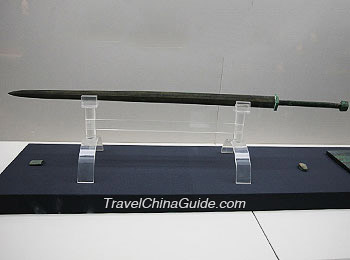 | | Bronze Sword | | 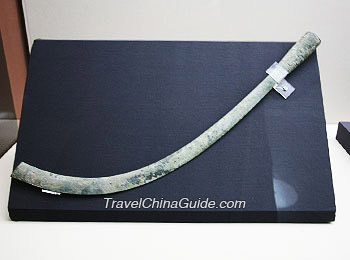 | | Bronze Billhook | |
Billhook
Called ‘Jin Gou’ in Chinese. Two bronze billhooks found in the east of Pit 1 have a shape similar to a machete. Equipped with an oval cylindrical hand shank, the bronze hook is manufactured as a double-edged weapon to wound people in both directions. It is also named the Wu hook because it was firstly created in Wu State.
Spear
Mao in Chinese. The bronze spears unearthed in the funerary pits are sharp and exquisite with silvery white color. Qin spears focus on actual combat performance, which reflects the spears’ simple and fluent lines, strong body, wide and flat shape as well as its sharp blade.
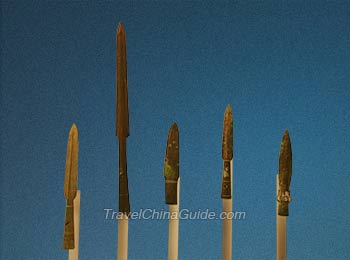 | | Spears | | 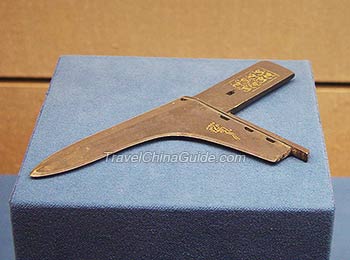 | | Dagger-Axe | |
Dagger-Axe
Known as Ge in Chinese, the dagger-axe is a pointed weapon commonly used in combat during the Shang and Zhou Dynasties (1600 BC - 256 BC). It is found in a long style and short style depending on the length of the handle. Archaeologists also find a few long inscriptions containing annals and names of the manufacturers on several non-Qin dagger-axes.
Halberd
Ji in Chinese. Regarded as the combination of Mao and Ge, the halberd has spear and dagger-axe heads for soldiers to stab and catch their combatant. Four halberds found in Pit 1 have decayed wooden handles but some inscriptions can still be seen on the heads.
Battleaxe
Its Chinese name is Yue. As one of the ritual weapons, the excavated bronze battleaxes are shaped similar to broad axes.
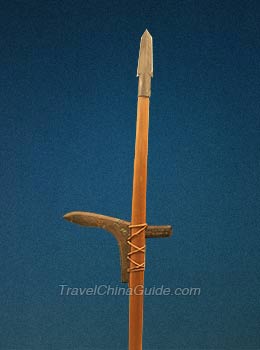 | | Halberd | | 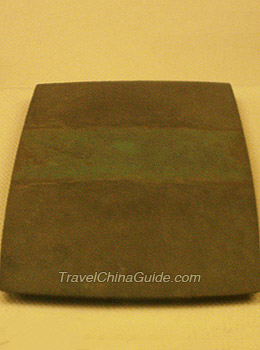 | | Bronze Battleaxe | |
Shu is the Chinese name. Almost 31 cylindrical Shu were discovered in Pit 1 and Pit 3. Its triangle cone head measures 10.5 centimeters (4.1 inches) long, and 2.3 to 3 centimeters (0.9 to 1.2 inches) in diameter. It was assembled with a wooden handle. Compared to combat weapons, such as spears and halberds, Shu is non-lethal and usually used only in ceremonies.
Bayonet
Pi in Chinese. Compared to a spear head, the 16 bayonet heads unearthed from Pit 1 are sharper and have stronger piercing force. They are about 35 centimeters (14 inches) long and have the same appearance as a dagger. The main part of the bronze bayonet is the bilateral hexahedral flat blade. Ended with a hole, the stem of the bayonet is compressed to be connected on the handle with a bronze nail.
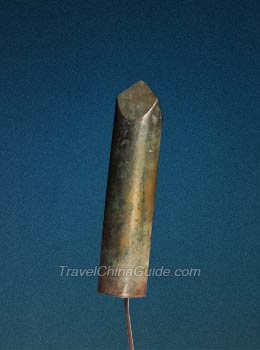 | | Shu | | 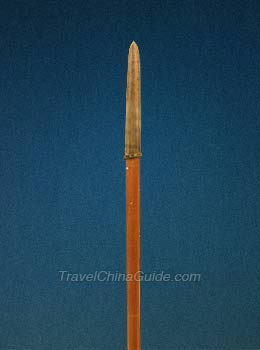 | | Bayonet | |
Nu in Chinese. As king of cold arms, Qin Nu is more powerful than the Qin bow because of its faster speed and further shooting distance. It not only has accurate aim, but also extended shooting range. The crossbow and bow were linked together when they were found. Both the bow and crossbow arm are wooden to take more tension and have a long effective range. The approximately 140-centimeter-long (55-inch-long) bow is covered by lacquer and strap, evident from remains of garment found on the crossbows. The bowstring length is between 108 and 124 centimeters (43 and 49 inches).
Arrowhead
Jiancu in Chinese. It is used with the crossbow. There are about 40,000 arrowheads unearthed from the terracotta warriors pits, including two iron arrowheads. The bronze heads are triangular pyramid and made up of head, shaft and vane.
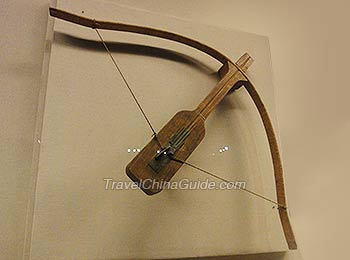 | | Crossbow of Qin Army | | 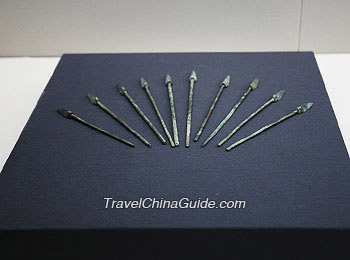 | | Bronze Arrowheads | |
How Advanced Were Qin Weapons Back Then?
As the earliest bronze weapons, the Qin weapons are considered to be the world's most powerful in its time by a lot of people. However, it's not true. The reason is that both of the quantity and quality of Qin weapons were left behind in that time, not only compared with other empires worldwide, but also compared with the previous states it conquered. In addition, the Qin bronze weapons manufacturing technique is proved to be not so advanced as well. More important reasons for the mightiness and prosperity of the Qin Empire are the correct military tactics, well-trained soldiers, and physical quality of the Qin soldiers.
- Last updated on Feb. 05, 2023 -
![]() Tip:
Tip:![]() See also Where are the weapons used to be in Terracotta Warriors' hands?
See also Where are the weapons used to be in Terracotta Warriors' hands?








